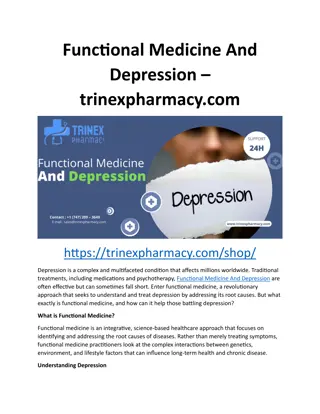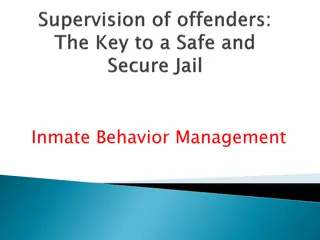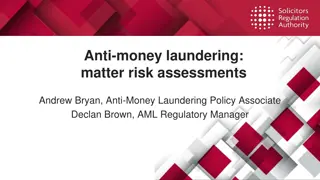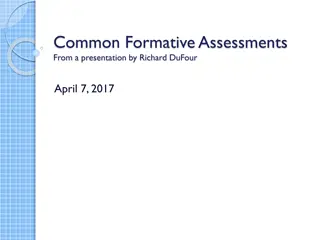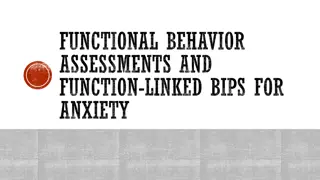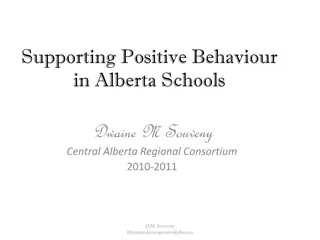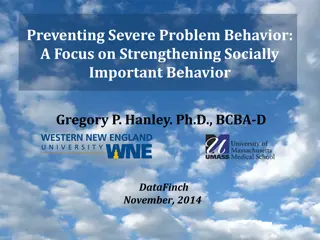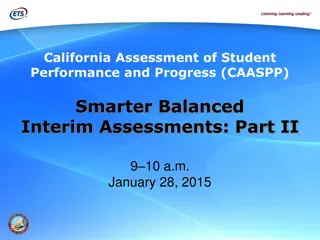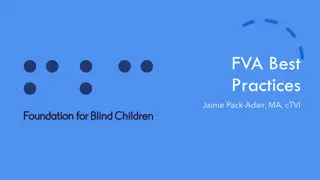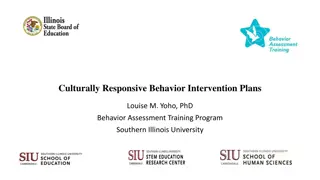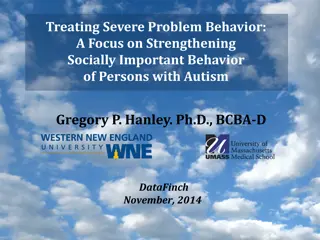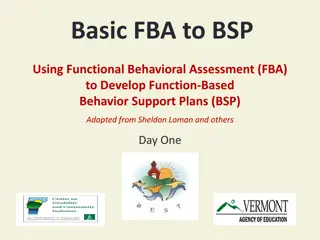Understanding Functional Behavior Assessments for Supporting Students
Functional Behavior Assessments (FBAs) play a crucial role in supporting students with behavioral needs by identifying the reasons behind inappropriate behaviors. This approach, led by professionals like Marcia L. Braden, Ph.D., helps define interventions, prevent problems, and teach alternative behaviors. Through workshops, video analyses, and case studies, participants learn to target specific behaviors for effective support and responses. The goal is to provide consistency and practical training to enhance student support, especially within the MTSS process and for students with disabilities.
- Functional Behavior Assessments
- Marcia L. Braden
- Student Support
- Behavioral Interventions
- FBA Methods
Download Presentation

Please find below an Image/Link to download the presentation.
The content on the website is provided AS IS for your information and personal use only. It may not be sold, licensed, or shared on other websites without obtaining consent from the author. Download presentation by click this link. If you encounter any issues during the download, it is possible that the publisher has removed the file from their server.
E N D
Presentation Transcript
Functional Behavior Assessments April 12, 2019 Marcia L. Braden, Ph.D., P.C. www.marciabraden.com Marcia L. Braden, PhD 1
Workshop Schedule 8:00 Sign in- Coffee/Announcements 8:15 Introductions and Experience with FBA s 8:45 -9:30 Foundations for Intervention Strategies 9:30 -10:30 What is an FBA ? 10:30-10:45 Break 10:45 -12:00 What is the Function and Why Is It So Important? 12:00-1:00 Lunch on your own 1:00 -2:00 Video Analysis and Case Studies 2:00-2:45 Behavioral Tools and Data Collection 2:45-3:00 Break 3:00-4:00 Continue Behavioral Tools and Questions Marcia L. Braden, PhD 2
Why Are We Here? To provide consistency for supporting students with behavioral needs through a defined documentation and procedural process. To support behavioral goals through the MTSS process, and/or students with disabilities. To provide practical training on FBA methods and tools. To prevent problem behaviors from occurring. To teach alternative behaviors To effectively respond when problem behaviors occur. Marcia L. Braden, PhD 3
We All See Things Differently What behavior would you choose to target? (video) 4
What Behavior Should Be Targeted? Attending to task at the computer Sensory dysregulation (chewing his shirt, hand flapping, sucking thumb) Social awareness Marcia L. Braden, PhD 5
Foundations for Intervention Strategies Marcia L. Braden, PhD 6
For example, perhaps the student has a hard time showing his work on math problems. In math class, he gets angry, crumples up the paper and is disruptive. He s sent to the principal s office. The behavior isn t appropriate, but it served its purpose. Your child managed to avoid doing the work that was frustrating him. He may not know that was his goal, but he found a way to deal with the math that was causing him stress. Case Study Illustration 7 Marcia L. Braden, PhD
What is a Functional Behavior Assessment? A functional behavior assessment is an approach to figuring out why the student acts a certain way. It uses a variety of techniques to understand what s behind inappropriate behaviors. This includes looking at non-academic factors that might be contributing to the student s frustration with learning. Marcia L. Braden, PhD 8
What is a Functional Behavior Assessment? Knowing what s behind inappropriate behavior can help you and the school find ways to change the behavior. The basic idea behind this approach is that your student s behavior serves a purpose. Whether he s aware of it or not, your student acts a certain way to get to a desired outcome or goal. Marcia L. Braden, PhD 9
What is a Functional Behavior Assessment? A key part of a functional assessment is figuring out what triggers certain behaviors in your student at home, in school and with friends. Sometimes parents and teachers assume they know what s causing a child s behavior because they ve seen other children do similar things. But it s important to remember that the causes for the same behavior can vary widely among children. 10 Marcia L. Braden, PhD
The Same Behavior with Different Functions Runs away but always goes to the kitchen location Running Susie A Runs away but looks back at the adults and laughs Runs from the facility and ends up in a variety of locations Susie B Susie C Marcia L. Braden, PhD 11
Functions that Behaviors Serve Problem Behavior Escape/ Avoid Something Obtain/Get Something Stimulation/ Sensory Tangible/ Activity Social Adult Peer Marcia L. Braden, PhD 12
Practical FBA Assessment vs. Comprehensive FBA Assessment A functional assessment has a narrower focus than a comprehensive evaluation. It focuses on the why, how, where, when and what of your child s behavior. A comprehensive evaluation is a process that s used to see if your child is eligible for special education services. It looks at all aspects of your child s learning. If behavior is a concern, a functional assessment may be part of the comprehensive evaluation process Marcia L. Braden, PhD 13
Practical FBA vs Comprehensive FBA Practical FBA Comprehensive FBA For: Students with mild to moderate problem behaviors (behaviors that are NOT dangerous or occurring in many settings) Students with moderate to severe behavioral problems; may be dangerous and/or occurring in many settings What: Relatively simple and efficient process to guide behavior support planning Time-intensive process that also involves archival records review, family- centered planning, and collaboration with agencies outside of school Behavior Support Team (e.g., school psychologists, behavior specialists) Conducted by whom: School-based personnel (e.g., teachers, counselors, administrators, MTSS team members) Marcia L. Braden, PhD 14
Observation format No need to get permission to assess Practical FBA s Requires fewer people on the team Requires no formal assessments Uses universal supports with some adaptations Marcia L. Braden, PhD 15
Behavior Intervention Plan Individual Child Specific modified curriculum, classroom accommodations such as sensory tools, preferential seating Interventions for Children with Behavior Challenges Support and supervision for social interaction, clear behavioral expectations, specific & consequences behavioral follow through Universal Strategies and Interventions Strategies that are good for all students, , Structure, predictability, basic accommodations, integrated curriculum, research based strategies, common behavioral programs such as Love and Logic Marcia L. Braden, PhD 16
Steps to Successful Inclusion Assessment _______________________________________ Student Name __________ Grade __________________ Date of Observation ______________________________________ General Education Teacher Name ____________________________ Observer Name _____________________ Length of Obs. (min.) _____________________________________________________________________________________ Defined Outcome Teacher Instruction Gen Ed Student Response Targeted Student Response Prompt Level 1 2 3 4 5 6 7 Prompt Level: NA = Not applicable and not counted in score calculations 0 = No correct response, even with prompts 3 = Correct response with visual, verbal, or gesture prompts; 1 = Correct response with full physical prompt for all of the instruction 4 = Correct response with no prompts; 2 = Correct response with partial physical prompt for part of the instruction Mastery = Correct response on 90% of the steps, without prompts, on 2 consecutive weekly observations. Marcia L. Braden, PhD 17
This observation format enables the team to compare the target student with others in the classroom setting. STSI Scoring and Reporting Results The data is taken with specific outcomes in mind such as social behavior, learning behavior, aberrant behaviors such as talking out, distractibility, work completion issues, etc. The data tells the team how the target student is different from his peers and what level of prompting is necessary to bring him success in the classroom. When you add the number of 4 s at the bottom out of the number of observations, you can determine the level of independence demonstrated in the classroom. Marcia L. Braden, PhD 18
The Comprehensive FBA Assessment Team Assessment is a team effort. Each team member sees your student from a different perspective. Everyone works together to figure out what s going on with your child s behavior. The assessment team varies from school to school. It typically includes a person with specialized training, such as a school psychologist or behavior specialist. That professional helps to gather information. She/He interviews people who know and work with the student. She/He will also speak to the student and do some screenings or assessments 19 Marcia L. Braden, PhD
Complete Teachers & school teams can complete a Request for Assistance form to refer a student for a Practical FBA Requesting a Practical FBA Talk Talk to school on obtaining parent permission to conduct a Practical FBA with a student Request Request for Assistance should give a broad picture of the student and their behaviors Marcia L. Braden, PhD 20
Steps to Performing a Meaningful FBA Step #1: Defining the inappropriate behavior Using vague words to describe your child s behavior can make it harder to gather the best information. Saying that your child is disruptive doesn t give enough information. Each one of us has definition for being disruptive- brainstorm definitions with the group 21 Marcia L. Braden, PhD
Steps to Performing A Meaningful FBA Team members work to pull together information from the student records, interviews and questionnaires. Their goal is to answer questions like: Where is this behavior happening? Where is it not happening? How often is the behavior occurring? Who is around when it occurs? What tends to happen right before and right after the behavior? What is a more acceptable behavior that can be used as a replacement? Step #2: Collecting, comparing and analyzing information. Marcia L. Braden, PhD
Collecting, Comparing and Analyzing Information, Comparing and Analyzing Comparing Team members work to pull together information from the student records, interviews and questionnaires. Their goal is to answer questions like: Where is this behavior happening? Where is it not happening? How often is the behavior occurring? Who is around when it occurs? What tends to happen right before and right after the behavior? What is a more acceptable behavior that can be used as a replacement? 23 Marcia L. Braden, PhD
Collecting, Comparing FUNCTIONAL ASSESSMENT SCREENING TOOL (FAST) adapt- fl.com/files/FAST.pdf Formal and informal interviews Motivation Assessment Mark Durand and Daniel Crimmins Functional Assessment and Intervention Team Meeting Record Scott, Liaupsin and Nelson 2002 Functional Assessment Checklist for Teachers and Staff (FACTS A&B) March, Horner, Lewis-Palmer, Brown, Crone, Todd and Carr, 2000 and Analyzing Information, Comparing and Analyzing Comparing Marcia L. Braden, PhD 24
Most Common Data Collection Strategies Frequency: A count of how many times the behavior is observed Rate: A measure of how many times the behavior was observed across some span of time like 60 times in an hour or an average rate of once per minute Percent correct: How many times did the student perform the skill accurately per some number of opportunities. Duration: How long did the behavior last from beginning to end? Latency: How long did it take for the behavior to begin once some trigger stimulus was present? Magnitude: Some measure of intensity or level of the behavior, often expressed on some sort of scale. Marcia L. Braden, PhD 25
Video Exercise Behavior(s) to be Targeted What is the setting? What is the targeted behavior? How is the behavior reinforced? (videos) 26 Marcia L. Braden, PhD
Steps to Performing a Meaningful FBA An ABC chart is a tool that s frequently used in this step. A stands for Antecedent (what happens before), B is for Behavior (the action or reaction), and C is for Consequence (what happens after). Marcia L. Braden, PhD 27
Physiological Environmental Antecedents Curricular Expectations Social Marcia L. Braden, PhD 28
Physiological Antecedents Red ears, face or neck Elevated heart rate,increase in perspiration Rapid speech which gets louder and cluttered Hand flapping or other stereotypies Hyperactivity Physically ill Marcia L. Braden, PhD 29
Loud and unfamiliar sounds Transitions and changes in routine Crowded conditions Artificial lighting or blinking lights Novel experiences Intense sensory input Environmental Antecedents Marcia L. Braden, PhD 30
Large noisy areas with many children can be over stimulating. Structure and space allotment makes the environment more tolerable. Some students have behavioral episodes because changing an environment is difficult. They are unsure of the expectation in different environments and with different staff. They often need a job or a transitional object in order to ease the anxiety connected with the transition. Crowded and Noisy Places/Transitions Marcia L. Braden, PhD 31
Students often want to appear as normal as their typical peers Highlighting their weaknesses by exposing their delays can provoke a behavioral reaction Curricular Antecedents Curricular adaptations allow the student with FXS to participate without feeling stressed by unrealistic expectations Marcia L. Braden, PhD 32
Social Antecedents Typical defenses to being overstimulated include: dropping to the floor, hiding behind a parent, chewing and mouthing objects and hiding behind hands Marcia L. Braden, PhD 33
Functional Behavior Assessment Step #3: Hypothesizing reasons for the behavior. A hypothesis is a best guess based on the information you have. The team works together to figure out what your child s behavior is telling them. What does he get out of ripping up his paper and being disruptive? It s the team s job to figure out what he is escaping, avoiding or getting from the behavior. Marcia L. Braden, PhD 34
Defining Observable Problem Behaviors Definitions of behaviors need to be: Observable: The behavior is an action that can be seen. Measurable: The behavior can be counted or timed. Defined so clearly that a person unfamiliar with the student could recognize the behavior without any doubts! Marcia L. Braden, PhD 35
Descriptive Data Sheet Frequency/ Duration of Behavior Room Circle One Date/Initials of Recorder Time Of Day Setting/ Specific Antecedent (Before Behavior) Topography (Behavior- What Does student Do?) Consequence (After Behavior- What Occurs After Behavior?) Return to Original Activity? Yes/No Examples here, but you can add your own Verbal Reprimand Intentional Redirection No Attention Remove task/act Provide access to item/act Other Distractions Sensory Activity Follow Through with Request Verbal Praise/Social Reinforcement No Attention Demand Denied access to item/act Alone Explain:____ ___________ ___________ ___________ ___________ ___________ ___________ ___________ This is where you list behaviors Marcia L. Braden, PhD 37
Behavioral Descriptors At the bottom of the data sheet, we operationalize the behavior. Explain a behavior such as Hitting: Any use of his hands to strike out and touch another person with impact. Eloping: Leaving or attempting to leave (walking or running) an activity or setting in which he is engaged or has been instructed to stay. Grabbing: Any extension of the hand or arm in the direction of an object or person accompanied by wrapping or attempting to wrap his fingers around that object or person. May but does not have to, be accompanied by squeezing of the object or person. Negative behaviors during transitions: any hitting, running, pinching or climbing while in transition from one person or location to another. Marcia L. Braden, PhD 38
Practice (videos) Marcia L. Braden, PhD 39
Latency in getting started- strategy to get him started Antecedent strategy to encourage him to make a choice What does regarding choices when she is asking for #3? Practice Assessment Voice and volume variation does he like it? What is antecedent for SIB? What antecedent strategy did she use right before asking him to place #6 on the second strip? Physical prompt Working for bubbles paired with social praise Marcia L. Braden, PhD 40
Case Study #1 Behavioral Detectives: A Staff Training Exercise Book in Applied Behavior Analysis Bobby Newman, Ph.D., B.C.B.A. and Dana R. Reinecke, Ph.D., B.C.B.A. Nancy was enrolled in preschool for children who were both typically developing and those diagnosed with developmental disabilities. When I arrived to observe at the program, I was informed by staff that aggression toward staff members had been escalating over the past several months. Nancy generally engaged in aggression by slapping out at staff members with a flat palm. The most common target of the aggression was Nancy s 1-to-1 aide, who was assigned to her both for behavior management and for adapting activities to her particular needs. A treatment plan had been put into place approximately six weeks earlier by the school psychologist attached to the program. The plan was based upon a meeting that had been held with relevant staff. No systemic functional analysis nor A -> B -> C data (information about behavior, what happened before, and what happened after it occurred) had been collected prior to the meeting, so the discussion consisted of interpretations of staff as they thought back on particular instances of Nancy s behavior. Staff expressed that the behavior was displayed across a variety of conditions, and for a variety of reasons. No clear function for the behavior had been determined. Staff decided to put a token economy system into place to discourage the slapping. The token economy consisted of the following: 41
Case Study #1 Continued A token board with 25 tokens already on it would be given to Nancy. If Nancy slapped at a staff member, a token was removed from the board (a response cost procedure). If there were any tokens left on the board at the end of each three-hour interval, Nancy would be allowed to choose a reinforcer from a menu of reinforcers. If Nancy did slap at a staff member, the staff member would say no slapping. The activity was not terminated unless aggression escalated to the point where staff felt that Nancy needed to be removed from the group to calm down. During the first observation, slapping was displayed at a very high rate. Nancy earned a reinforcer (she chose computer time) during the first three-hour interval of the day, but did not earn a reinforcer during the second three-hour interval. In fact, Nancy lost all her tokens within the first hour of the second three-hour block. Behavior continued to escalate for the remainder of the day. On subsequent days, she rarely earned any reinforcement, until we adjusted the treatment plan. Marcia L. Braden, PhD 42
Case Study #2 and Discussion Jim was participating in a home program, and a very well-designed one at that. Programming was intensive and followed an excellent sequence. Staff were well- trained, and members of the family all were highly knowledgeable about current programming steps. The increase in hitting had prompted the head programmer to suggest that they put a DRO program into place. For ten minute periods that did not include any such aggression, a letter would be added to his token board. When Jim had spelled out I earned computer, he would be able to go use the computer for ten minutes. The failure of the program was somewhat mysterious. Jim had used token economies in the past, and they had been effective motivators as he had transitioned from primary to conditioned and then generalized reinforcers. The activity reinforcer also did not seem to be the issue. All agreed that Jim found the computer reinforcing. It had been used in this capacity in the past. He happily spent time on the computer when not in session. To date, however, the DRO program within session had not been remarkably effective in reducing the competing behavior. Hitting was still occurring, and this was obviously interfering with the learning process. Marcia L. Braden, PhD 43
Case Study #3 In our next scenario, we find ourselves in that tight spot when a treatment plan has been put into place, but the data aren t showing a change in the desired direction. When such things happen, the two most obvious factors to check are: Is this the right plan (i.e., have we done our functional analysis/assessment well)? If this is the right plan, is everyone carrying it out correctly? Just to give a hint, it turns out neither of these common and obvious reasons was valid. Let us once again forge ahead. Melissa was a young girl diagnosed with moderate mental retardation. She was doing well within her program, but progress was being impeded by frequent bouts of noise-making. According to the paperwork I inherited, Melissa would make silly noises or begin to sing, at seemingly random intervals. Unable to identify a clear function for the behavior, the staff had put a Differential Reinforcement of Other behavior (DRO) plan into place to try to give Melissa an incentive to refrain from the behavior. Marcia L. Braden, PhD 44
Case Study #3 continued As I observed the plan in action, the failure to show improvement was not immediately obvious. Melissa s staff were very diligent in carrying out the DRO plan. Every minute on the minute, if she refrained from engaging in the noise-making, a reinforcer was delivered. Melissa always reached for and accepted the reinforcer, indicating that the reinforcers were probably motivating. An informal eyeballing of the situation seemed to indicate that the behavior was decreasing. The graph doesn t lie, however, despite my subjective impressions. Staff were keeping very careful partial-interval recording data. Looking at the graph, 100% of the 30-minute intervals showed at least one inappropriate noise emitted by Melissa. Discussion Marcia L. Braden, PhD 45
Developing A Behavior Plan Once the team has an idea of the reasons behind your child s inappropriate behavior, the team works closely with the behavior specialist or psychologist to find ways to see if the hypothesis is right. This means changing something in the environment to see if it changes the behavior. To do this, they create a behavior intervention plan (BIP). A BIP is a plan that s designed to teach and reward positive behaviors. This can help prevent or stop problem behaviors in school. Marcia L. Braden, PhD 46
Legal Name of Student BEHAVIOR INTERVENTION PLAN (BIP) 1. Sources of Information List sources of information used in FBA, both formal and informal, to develop this plan. File review, and observations from Aug 2018 until present. Observations in a variety of settings to include school including different structure (small group, general education setting, 1:1 in DD classroom. 2. Strength Based Profile Identify skills and interests, positive relationships, pro-social behaviors, family and community supports, and other protective factors. X is interested in science and discussing his topics of interest. He is very interested in learning the meaning of new words. X readily engages in activities he enjoys. When he is regulated, he is friendly with his peers and enjoys playing with them. X takes regular breaks in our sensory room and is calmed by rocking in the rocking chair and looking at our world and United States maps. X interacts well and is very helpful with younger children. His fifth-grade teacher reports he is intelligent and likes to share facts, especially in the area of technology and science. 3. Functional Behavioral Assessment (FBA) Summary Statement Describe specific problem behavior and summary/hypothesis statement from FBA. X s behavior was tracked from 1-31-19 to present. His school team used a behavioral protocol sheet listing time of engagement in activities, the academic task and if he was able to complete the academic task. The results indicated that from 1-31-19 until 2-15-19, X engaged in 51/60 tasks presented over 10 days and went home one of 12 days for aggression. He had six episodes of dysregulation in 10 days. In addition, a descriptive data sheet was used to track the setting, antecedent, behavior and consequence for five days. The antecedent was always a demand from the staff to engage in some sort of work task and the behaviors included slapping his face, poking himself with a pencil, banging his head, yelling or crying that the work was too hard and needing help, asking to be left alone slamming his hand on a computer, tearing up or throwing work or work tools and sitting without working. State Student ID Date Of Birth Date Marcia L. Braden, PhD 47
Hypothesis/Summary statements A statement of student behavior that provides a hypothesis of the: Operational definition of problem behavior Antecedent variables that trigger the problem behavior Functions maintaining the problem behavior e.g., Get/Avoid Attention/Activity Accuracy of summary statements will provide a metric for the efficacy of the FBA Marcia L. Braden, PhD 48
Legal Name of Student BEHAVIOR INTERVENTION PLAN (BIP) 4. BIP Strategies/Outcomes Worksheet Based on hypothesis, in the table below, identify the strategy, what will be done, when and where the strategy will occur. Setting Event Strategies (Reduce impact of setting events) State Student ID Date Of Birth Date Antecedent Strategies (Decrease likelihood that behavior will occur) Behavior Teaching Strategies (Alternative Behaviors) (Increase the likelihood that the appropriate replacement behavior will occur through instruction) Reinforcement Strategies (Consequence) (When student demonstrates the desired behavior, the need behind the behavior is met e.g. obtain or avoid) Document progress by taking data on behavior and chart using charts and graphs, provide non- contingent reinforcement of good behavior, provide opportunities for cognitive challenges and high interest activities as reinforcement provide choices of reinforcement activities and provide positive praise without loud voice or excessive animation. Predictable daily schedule, sensory breaks, 1:1 instruction, clearly defined expectations, quiet work environment, access to noise buffers, reduced verbiage from staff, emphasis on visual instruction, advanced notice for transitions, communication with parents related to changes in routine or physical conditions related to medication regulation, A-B Day protocols. Controlled environment with limited changes in people, schedule and transitions on a B Day. Choices for order of academic tasks in his daily schedule on a B Day, sensory strategies integrated into daily schedule used proactively, incentive to meet expectations, access to high interest materials. Accommodations listed in IEP provided in all environments, reduced verbiage and visual supports, neutral responses to attention seeking behaviors. Ignore attempts to engage in power struggles, model asking for help, teach asking for a break with sensory tools, teach to communicate a need to discuss his feelings, teach to access adaptive sensory activities to replace attempts to seek sensory input, reduce demands to promote engagement when dysregulated (B Day), use high interest materials to build learning momentum and engagement. Marcia L. Braden, PhD 49
Legal Name of Student BEHAVIOR INTERVENTION PLAN (BIP) 5. Crisis Intervention Plan Outlined in the behavioral protocol 6. Evaluation Indicate how the plan will be measured and by whom. Identify the desired performance level for either increasing the occurrence to the identified alternative behavior(s) or decreasing the occurrence of the behavior of greatest concern (criterion for success). X s work refusal coupled with yelling and crying that the work is too hard, throwing and destroying work or work tools, engaging in SIB, will be tracked and tallied daily in 2.5-hour increments. Reduction of behaviors will be tracked using data collection. Criteria will be met when behaviors are reduced by 20% for 5 consecutive data days. Baseline 2-22-19: Yelling/ crying 5x in 2.5 hours, Destruction of work or work tools 2.5 x in 2.5hrs, SIB 5x in 2.5 hours. If the data shows an increase of 20% for more than three days, the team will reassess to determine if the strategies are effective. Continuous Progress Monitoring Method: Frequency count prorated for hours spent at school Person Responsible: Teacher X Criterion for Success: Follow-up Meeting Date: Criteria will be met when behaviors are reduced by 20% for 5 consecutive data days. Baseline 2-22-19: Yelling/ crying 5x in 2.5 hours, Destruction of work or work tools 2.5 x in 2.5hrs, SIB 5x in 2.5 hours. State Student ID Date Of Birth Date Marcia L. Braden, PhD 50




